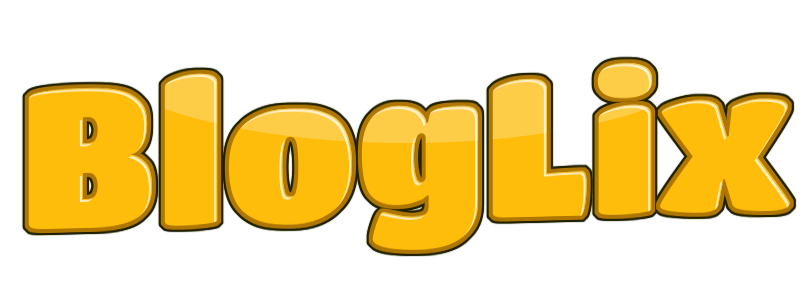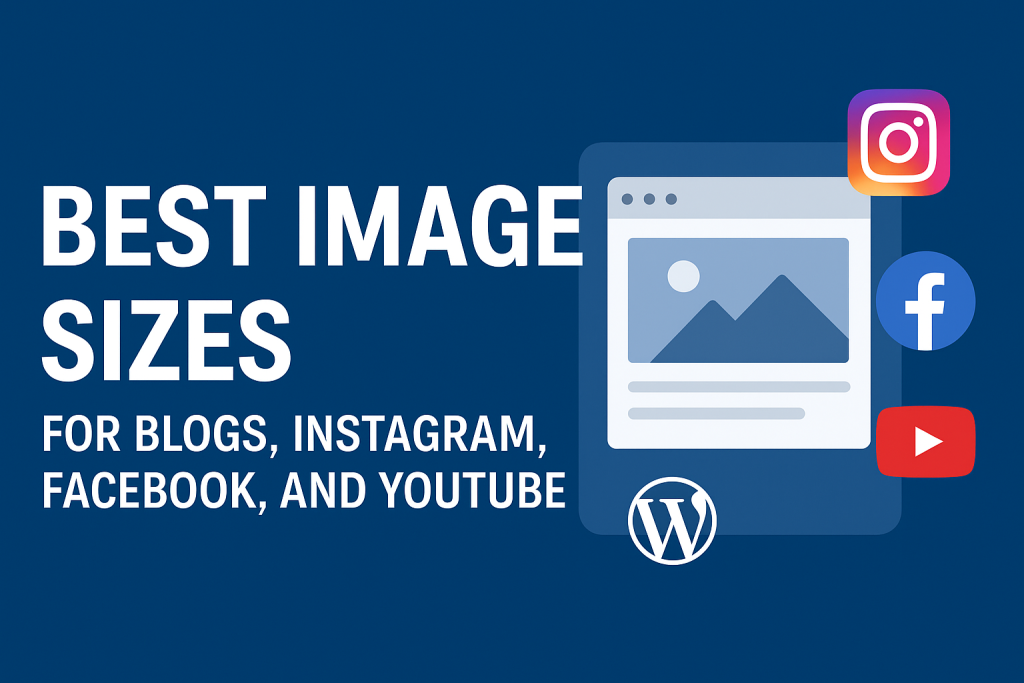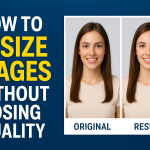Table of Contents
ToggleIntroduction: Why Image Sizes Matter More Than You Think
You’ve spent hours crafting the perfect blog post or social media update. The text is engaging, the message is clear—but then the image uploads in the wrong size. Suddenly, your post looks awkward, cropped, or blurry.
It’s a common mistake, and it can cost you engagement, credibility, and even search rankings. The right image sizes ensure your visuals load fast, look sharp, and capture attention across different platforms.
In this guide, we’ll explore the best image sizes for blogs, Instagram, Facebook, and YouTube—the four most important platforms for content creators and digital marketers. By the end, you’ll have a practical cheat sheet to make your visuals shine.
Why Optimized Image Sizes Are Essential
Before diving into specific platforms, let’s cover why image sizes matter in the first place:
-
Professional Appearance: Correctly sized images prevent awkward cropping or pixelation.
-
Faster Load Times: Large, unoptimized images slow down websites and social feeds.
-
Better SEO: Search engines favor pages with optimized images.
-
Increased Engagement: Sharp, properly displayed visuals attract more likes, shares, and clicks.
-
Consistent Branding: Unified visuals across platforms build brand recognition.
When I first launched my blog, I uploaded oversized images straight from my camera. My pages took forever to load, and bounce rates skyrocketed. Once I optimized image sizes, my traffic improved by 20% in a month.
Best Image Sizes for Blogs
Blogs are often the first step for content creators and businesses. The wrong image size can make posts look cluttered or slow to load.
Recommended Blog Image Sizes
-
Featured Image (Header/Banner): 1200 x 628 pixels (works well for sharing on social media too).
-
In-Content Images: 600–800 pixels wide (scaled to fit text width).
-
Thumbnail (for lists, previews, or sidebars): 150 x 150 pixels.
Pro Tips for Blogs
-
Use landscape orientation for most featured images—it adapts better across devices.
-
Convert images to WebP format for faster loading without losing quality.
-
Always compress images with tools like TinyPNG or ShortPixel before uploading.
Related resource: Check out [how to compress large images without losing quality] for step-by-step optimization.
Best Image Sizes for Instagram
Instagram is all about visuals. Wrong dimensions can crop out key details or make your feed look inconsistent.
Recommended Instagram Image Sizes
-
Profile Picture: 320 x 320 pixels.
-
Feed Posts:
-
Square: 1080 x 1080 pixels.
-
Portrait: 1080 x 1350 pixels.
-
Landscape: 1080 x 566 pixels.
-
-
Instagram Stories & Reels: 1080 x 1920 pixels.
-
IGTV Cover Photo: 420 x 654 pixels.
Pro Tips for Instagram
-
Stick to aspect ratios: 1:1 for squares, 4:5 for portraits, and 16:9 for landscapes.
-
Use the highest quality image (1080p width minimum) to avoid compression.
-
Maintain consistent colors and fonts for brand recognition.
Quick Visual Guide for Instagram:
| Type | Size (px) | Aspect Ratio |
|---|---|---|
| Profile Picture | 320 x 320 | 1:1 |
| Feed (Square) | 1080 x 1080 | 1:1 |
| Feed (Portrait) | 1080 x 1350 | 4:5 |
| Feed (Landscape) | 1080 x 566 | 16:9 |
| Stories/Reels | 1080 x 1920 | 9:16 |
Best Image Sizes for Facebook
Facebook supports many types of visuals—profile pictures, covers, ads, and shared posts. Using the right image sizes ensures your content looks professional across devices.
Recommended Facebook Image Sizes
-
Profile Picture: 170 x 170 pixels.
-
Cover Photo: 820 x 312 pixels (desktop) / 640 x 360 pixels (mobile).
-
Shared Image Post: 1200 x 630 pixels.
-
Event Cover Photo: 1920 x 1005 pixels.
-
Facebook Ads: 1080 x 1080 pixels (square) or 1200 x 628 pixels (landscape).
Pro Tips for Facebook
-
Keep important elements centered—covers crop differently on desktop and mobile.
-
Use square images for ads; they perform better in feed placements.
-
Stick to Facebook’s 20% text rule for ad images (minimal text = higher reach).
Facebook Image Size Cheat Sheet
| Type | Size (px) |
|---|---|
| Profile Picture | 170 x 170 |
| Cover Photo | 820 x 312 |
| Shared Post Image | 1200 x 630 |
| Event Cover Photo | 1920 x 1005 |
| Ad Image (Square) | 1080 x 1080 |
Best Image Sizes for YouTube
YouTube is the second-largest search engine after Google, and visuals play a critical role in attracting clicks and subscribers.
Recommended YouTube Image Sizes
-
Profile Picture (Channel Icon): 800 x 800 pixels.
-
Channel Art (Cover): 2560 x 1440 pixels (safe zone: 1546 x 423 pixels).
-
Video Thumbnail: 1280 x 720 pixels.
Pro Tips for YouTube
-
Keep important text and visuals in the “safe zone” of channel art, so they don’t get cut off on smaller screens.
-
Always upload custom thumbnails—they boost click-through rates significantly.
-
Use high-contrast colors and readable fonts in thumbnails.
YouTube Image Size Guide
| Type | Size (px) |
|---|---|
| Profile Picture | 800 x 800 |
| Channel Art | 2560 x 1440 |
| Safe Zone (Channel) | 1546 x 423 |
| Video Thumbnail | 1280 x 720 |
How Image Sizes Affect Engagement and SEO
The right image sizes do more than just make your posts look good—they directly influence performance:
-
Faster Load Times = Better SEO
Large, unoptimized images slow sites down. Google prioritizes speed. -
Right Dimensions = Higher Engagement
Instagram posts with the correct aspect ratio get more likes. Facebook ads with square images outperform landscape ones. -
Consistent Visuals = Stronger Branding
Audiences recognize your style faster when your images are consistent across platforms.
Common Mistakes to Avoid
-
Uploading Oversized Images – Slows down websites unnecessarily.
-
Ignoring Aspect Ratios – Leads to awkward cropping.
-
Forgetting Mobile Optimization – Images look fine on desktop but broken on mobile.
-
Not Compressing Before Upload – Even correctly sized images can be heavy.
-
Reusing the Same Image Across Platforms – Each platform has unique size needs.
Fresh Perspectives: Lessons from Experience
When I first started creating social media campaigns, I used the same images across Facebook, Instagram, and YouTube. The result? Logos got cropped, text cut off, and engagement suffered.
After tailoring images to the recommended sizes, everything improved. Engagement rates increased by 25%, bounce rates dropped, and my brand felt more polished across platforms.
Future Trends in Image Sizes
-
Dynamic Resizing with AI: Platforms may auto-resize intelligently while preserving design intent.
-
Universal Formats (like WebP/AVIF): Expect smaller, sharper files optimized for all platforms.
-
Responsive Branding: Brands will design “modular” visuals that adapt seamlessly across devices.
Conclusion: Right Sizes, Big Impact
Using the correct image sizes is one of the simplest yet most powerful steps you can take to improve your online presence. From blogs to Instagram, Facebook, and YouTube, optimized visuals load faster, look sharper, and engage better.
Don’t let poor visuals hold back your content. Invest time in creating images at the right dimensions, and you’ll see measurable improvements in engagement, branding, and SEO.
Call to Action
✅ Ready to optimize your visuals? Start by resizing your next blog image or social media post to the recommended dimensions above by using IMGpapa image resizer.
Have you struggled with uploading the right image sizes? Share your experiences in the comments below—and subscribe for more practical guides on content optimization and digital marketing!



